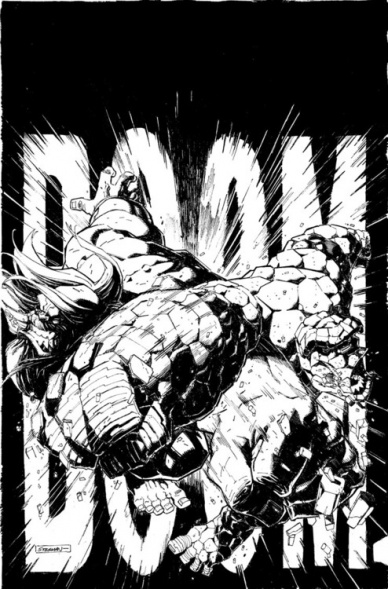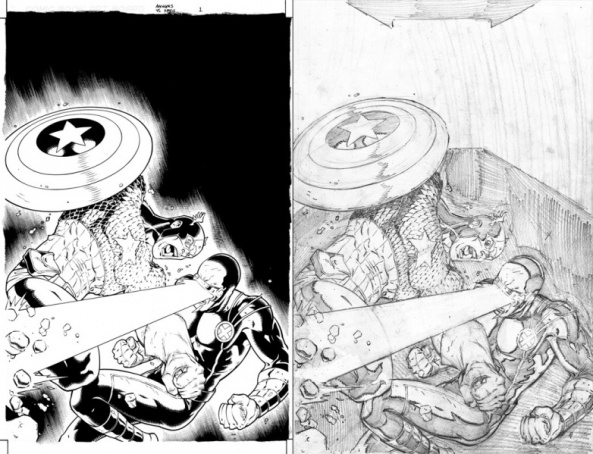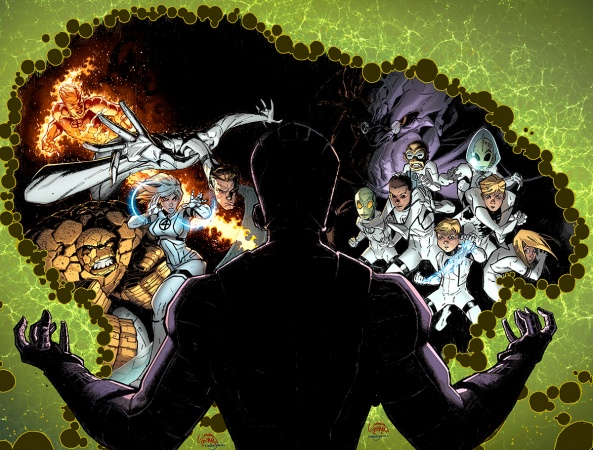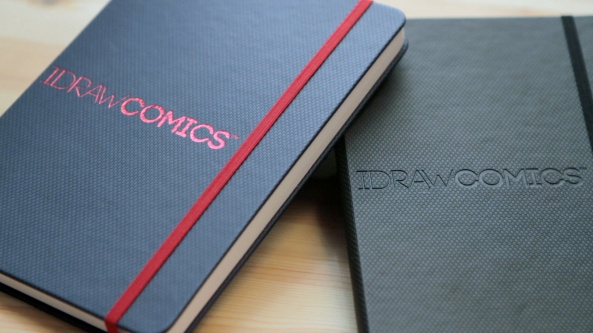
He’s Fantastic in groups. He’s been known to have Incredible strength. He’s Amazing in motion. He’s even been known to pull off Scarlet. Ladies and gentlemen, today for Artist August we are very pleased to be talking with Mr. Ryan Stegman!
Take a look below for a chat about his career, his recent past with “Scarlet Spider,” his present with “Fantastic Four” and what lies ahead in the not-to-distant future.
Can you look back on your life and recall the single moment that made you want to work in comics? Or was it more of a natural progression that led you here?
Ryan Stegman: Actually, yes! I went to the chiropractor because I needed some back adjustments because I was a tall gangly kid and I was growing a bit too fast. I was 15. On the way out, there was a comic book store and I stopped in and picked up Spawn 47. It was on a whim. I then proceeded to almost have a heart attack and I read that issue over. And over. And over. And took it everywhere with me. I then started stealing quarters from my dad once a month to buy the newest issue. Then I told my parents that I wanted to be a comic book artist and that was that.
Who or what has influenced the development of your art the most?
RS: Well, I have to say Todd McFarlane and Greg Capullo are my original influences. My influences have branched out since then and there are too many to name. But those guys had the earliest impact on me. And then a lot of my friends helped me find my way. Namely Skottie Young. We spend more time talking about comic book art than should even be legal.
There are many tools available to artists today that allow the expansion of your work, such as tablet devices that allow for a different form of illustration. Do you use any digital devices at all for your work, are you strictly ink and paper, or perhaps some combination of both?
RS: A combination. I do my breakdowns digitally and then I print it onto the board and pencil it and ink it. When I say breakdowns, I just mean wireframe gestural drawings. Just something to make sure my compositions are tight. I’d say it’s about 80% traditional.

In your recent “Scarlet Spider” run, one of the stand-out elements to me was the use of motion with Kaine in action and web slinging. How do you particularly come at the idea of motion in a still image to help really drive that action across to the reader?
RS: Well, artists that really sell motion are the ones that attract me the most. So it’s something that I really get into. I’ve stolen a lot of stuff from the Greg Capullos and Joe Madureiras over the years and I try to incorporate that stuff. I also take a ton from manga. Akira is like a bible on how to draw motion. But motion really pumps me up, so I just try and push everything to the extreme.
You recently switched from Marvel’s “Scarlet Spider” relaunch to “Fanastic Four” and “FF,” which are fairly different books conceptually. When looking at the two, specifically in their dynamics, which do you prefer working on — the hustle and bustle of a team adventure or the solo stories of a lone hero?
RS: I enjoy both for different reasons. The Fantastic Four offers you the opportunity to draw different characters all the time, which helps prevent you from getting stale. Like if I have a day drawing Reed and I get bored, the next day I’m drawing the Thing and I’m happy again.
With a single character story you draw a lot LESS though, and that appeals to me! Haha. But I’m never gonna complain about drawing the Fantastic Four. So they both have their strengths and weaknesses.

You’re working on the final arc of “Fanastic Four” with Jonathan Hickman, as well as the final issue. Given the scope of the run and the amount of talent who has worked on the book so far, how does it feel to get the final stamp in a defining run?
Continued belowRS: It feels…Surreal. I guess sometimes I feel like a bit of a fraud even because it just feels crazy. It’s hard to put it in perspective because you start out doing small stuff for next to no money in indy comics and then the progression is so slow to get to where I’ve gotten that it almost doesn’t feel any different. It IS different, but I still just go down to my basement every day and draw at the same desk I’ve been drawing at all along. Yet…I’m drawing a book that Jack Kirby created! AAAAAHHHHH!!!!!
You’ve been posting a lot of teases of these issues online in places such as Instagram, showing off a lot of sleek character work. When working with Marvel’s First Family, are there any particular previous runs you look at for inspiration with your own?
RS: Well, Jack Kirby’s obviously. And I’ve really taken to Walt Simonson’s run and then John Byrne’s given me a ton of inspiration.
To that same end, without giving away anything of course, what in your arsenal are you planning to bring to the Fantastic Four to leave your own definitive mark on the characters?
RS: Um…I guess I just try to do things as awesome as possible. I always try to keep that in mind. When I picked up that first Spawn issue at 15 years old, it was mind-blowingly awesome. And I want to blow minds like that. I think that stylistically the characters will look like mine as long as I don’t leave my personal style at the door and just do what I do.

You’ve also recently worked on some of the exclusive variants to Marvel’s big summer event, “Avengers vs X-Men.” Given the amount of pull a sharp cover can have (especially a frameable variant), what strategies or techniques do you use to craft to hopefully entice collectors?
RS: All I wanted to do on those was have awesome shots of characters fighting. That’s always awesome! Thankfully, I think people have taken to the covers for the most part. But I don’t know that I really think of collectors so much as what do I think would be cool. And then hopefully my thoughts of cool line up with the collectors’ opinions!
We live in a fairly connected world this day and age, what with the advent of social networking. Does feedback (both positive and negative) with fans and critics via things like Twitter and comment sections on websites push you as an artist? How does that aspect affect your art?
RS: As any of my friends can tell you, I am overly affected by comments! But it’s a good thing. I never write any comment off, there’s always some truth to them. I just try to decipher the truth and then figure out how to make my work better.
But even better than that is the interaction that I get to have with other artists on a daily basis. Studios are the exception, not the norm now. But I don’t feel like I’m at home working alone. I talk to my art buddies all day on Skype and we pass around what we’re working on constantly. We constantly offer feedback and it helps me to grow as an artist one page at a time.
Who are your favorite artists working in comics today?
RS: So many. Capullo is obviously lighting it up on Batman. I love anything Art Adams does. Anytime I can get a Joe Madureira fix I’m happy. Olivier Coipel, Sean Murphy, Rafael Albuquerque, Fiona Staples, Skottie Young, Frank Quitely, etc. I’m missing so many. I could go on all day.

Looking back at your career in Marvel so far, with many a title under your belt and many a fan favorite run, how do you feel you’ve grown since you’ve begun work with the company in 2010? What do you feel are the highlights so far?
RS: I’ve become a better artist! I’m much more in control of my craft now. When I started out, every page was a struggle to get it right. Now I worry less about that and more about the subtle nuances of a page. I’m much more concerned with being myself than trying to draw like anybody else. So as I go on the pages are going to get more and more “Stegman-y”.
Continued belowThe highlights for me are too many to name. I’ve particularly enjoyed the Sif one-shot I did. It’s such a well-written comic (by Kelly Sue DeConnick). It’s just so packed with goodness. And I felt like I put a lot of stuff together in there as an artist. She-Hulks was short-lived but a real thrill. And I did Amazing Spider-Man 665, which, no matter what I do, will probably always be my favorite single issue I’ve ever done. My art will get better, but working on that book is and always has been my dream. And you couple that with the fact that I got the email asking me to draw that issue shortly after my son Oliver was born…Man. A perfect storm of awesome. Plus, that Slott character wrote a phenomenal script. And then Scarlet Spider was SO gratifying. To launch a book that nobody would have thought would succeed and then to smash all expectations was so great. And then lastly, to work on FREAKING FANTASTIC FOUR?!!!!! Come on!
Comics are implicitly a visual medium, but often times the art aspect seems to come secondary to the writing for many fans and critics. Do you agree, and if so why do you think that’s the case?
RS: Not to say that art is more important than writing. But art is what makes comics COMICS. You can get writing in all other sorts of media. TV, novels, movies etc. But you can only get comic book art IN COMICS.
I think that we are in this place where writing is so heavily valued because writers can write multiple books a month. Plus, it’s the swinging of the pendulum from the 90s when artists controlled the universe. Also, artists don’t do long runs on books anymore. Some do, but the demands of comic book art have become pretty extreme and it makes it very hard to do a full issue in 4 weeks. So we get shuffled around and that marginalizes us. BUT…See my answer to the next question…

Once the final issues of Fantastic Four wrap up, what does the future hold for Ryan Stegman?
RS: All I can say is, I’ll be on something awesome for a good long while. That’s what I wanted, and I told Marvel that and they obliged. I can’t say what it is, but yeah. I’ll be sticking somewhere for a while instead of bouncing around!
Also, I have a comic book instructional book coming out called “I DRAW COMICS”. If you have any interest in drawing comics, check it out at idrawcomics.net!






